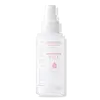What's inside
What's inside
 Key Ingredients
Key Ingredients

 Benefits
Benefits

 Concerns
Concerns

No concerns
 Ingredients Side-by-side
Ingredients Side-by-side

Water
Skin ConditioningPropanediol
SolventPentylene Glycol
Skin ConditioningPvp
Emulsion StabilisingPolyglyceryl-10 Myristate
Skin ConditioningGlycerin
HumectantAlpinia Speciosa Flower/Leaf/Stem Water
AntimicrobialPhytosteryl/Octyldodecyl Lauroyl Glutamate
Skin ConditioningPhenoxyethanol
PreservativeCeramide AP
Skin ConditioningMicrocitrus Australasica Fruit Extract
Tocopherol
AntioxidantPotassium Ascorbyl Tocopheryl Phosphate
AntioxidantSodium Citrate
BufferingCitric Acid
BufferingWater, Propanediol, Pentylene Glycol, Pvp, Polyglyceryl-10 Myristate, Glycerin, Alpinia Speciosa Flower/Leaf/Stem Water, Phytosteryl/Octyldodecyl Lauroyl Glutamate, Phenoxyethanol, Ceramide AP, Microcitrus Australasica Fruit Extract, Tocopherol, Potassium Ascorbyl Tocopheryl Phosphate, Sodium Citrate, Citric Acid
Water
Skin ConditioningGlycerin
HumectantPropanediol
SolventGlyceryl Stearate Se
EmulsifyingCaprylyl/Capryl Glucoside
Cleansing1,2-Hexanediol
Skin ConditioningCaprylyl Glycol
EmollientHydroxyacetophenone
AntioxidantPullulan
Parfum
MaskingHyaluronic Acid
HumectantGlucose
HumectantPolyglyceryl-10 Stearate
Skin ConditioningLimonene
PerfumingCurcuma Longa Root Extract
MaskingTriethyl Citrate
MaskingPolyglyceryl-6 Behenate
Emulsion StabilisingCeramide NP
Skin ConditioningHexyl Cinnamal
PerfumingCeramide AP
Skin ConditioningCholesterol
EmollientPhytosphingosine
Skin ConditioningBehenic Acid
CleansingCetearyl Alcohol
EmollientGlyceryl Stearate
EmollientSodium Levulinate
Skin ConditioningPotassium Sorbate
PreservativeCitric Acid
BufferingSodium Cetearyl Sulfate
CleansingCeramide EOP
Skin ConditioningWater, Glycerin, Propanediol, Glyceryl Stearate Se, Caprylyl/Capryl Glucoside, 1,2-Hexanediol, Caprylyl Glycol, Hydroxyacetophenone, Pullulan, Parfum, Hyaluronic Acid, Glucose, Polyglyceryl-10 Stearate, Limonene, Curcuma Longa Root Extract, Triethyl Citrate, Polyglyceryl-6 Behenate, Ceramide NP, Hexyl Cinnamal, Ceramide AP, Cholesterol, Phytosphingosine, Behenic Acid, Cetearyl Alcohol, Glyceryl Stearate, Sodium Levulinate, Potassium Sorbate, Citric Acid, Sodium Cetearyl Sulfate, Ceramide EOP
 Reviews
Reviews

Alternatives
Ingredients Explained
These ingredients are found in both products.
Ingredients higher up in an ingredient list are typically present in a larger amount.
Ceramide AP is formally known as Ceramide 6.
Ceramides are intercellular lipids naturally found in our skin that bonds dead skin cells together to create a barrier. Having a strong skin barrier leads to more firm and hydrated skin.
They are known for their ability to hold water and thus are a great ingredient for dry skin. By bolstering the skin ceramides act as a barrier against irritating ingredients. This can help with inflammation as well.
If you would like to eat ceramides, sweet potatoes contain a small amount.
Read more about other common types of ceramides here:
Ceramide NP
Ceramide EOP
Citric Acid is an alpha hydroxy acid (AHA) naturally found in citrus fruits like oranges, lemons, and limes.
Like other AHAs, citric acid can exfoliate skin by breaking down the bonds that hold dead skin cells together. This helps reveal smoother and brighter skin underneath.
However, this exfoliating effect only happens at high concentrations (20%) which can be hard to find in cosmetic products.
Due to this, citric acid is usually included in small amounts as a pH adjuster. This helps keep products slightly more acidic and compatible with skin's natural pH.
In skincare formulas, citric acid can:
While it can provide some skin benefits, research shows lactic acid and glycolic acid are generally more effective and less irritating exfoliants.
Most citric acid used in skincare today is made by fermenting sugars (usually from molasses). This synthetic version is identical to the natural citrus form but easier to stabilize and use in formulations.
Read more about some other popular AHA's here:
Learn more about Citric AcidGlycerin is already naturally found in your skin. It helps moisturize and protect your skin.
A study from 2016 found glycerin to be more effective as a humectant than AHAs and hyaluronic acid.
As a humectant, it helps the skin stay hydrated by pulling moisture to your skin. The low molecular weight of glycerin allows it to pull moisture into the deeper layers of your skin.
Hydrated skin improves your skin barrier; Your skin barrier helps protect against irritants and bacteria.
Glycerin has also been found to have antimicrobial and antiviral properties. Due to these properties, glycerin is often used in wound and burn treatments.
In cosmetics, glycerin is usually derived from plants such as soybean or palm. However, it can also be sourced from animals, such as tallow or animal fat.
This ingredient is organic, colorless, odorless, and non-toxic.
Glycerin is the name for this ingredient in American English. British English uses Glycerol/Glycerine.
Learn more about GlycerinPropanediol is an all-star ingredient. It softens, hydrates, and smooths the skin.
It’s often used to:
Propanediol is not likely to cause sensitivity and considered safe to use. It is derived from corn or petroleum with a clear color and no scent.
Learn more about PropanediolWater. It's the most common cosmetic ingredient of all. You'll usually see it at the top of ingredient lists, meaning that it makes up the largest part of the product.
So why is it so popular? Water most often acts as a solvent - this means that it helps dissolve other ingredients into the formulation.
You'll also recognize water as that liquid we all need to stay alive. If you see this, drink a glass of water. Stay hydrated!
Learn more about Water